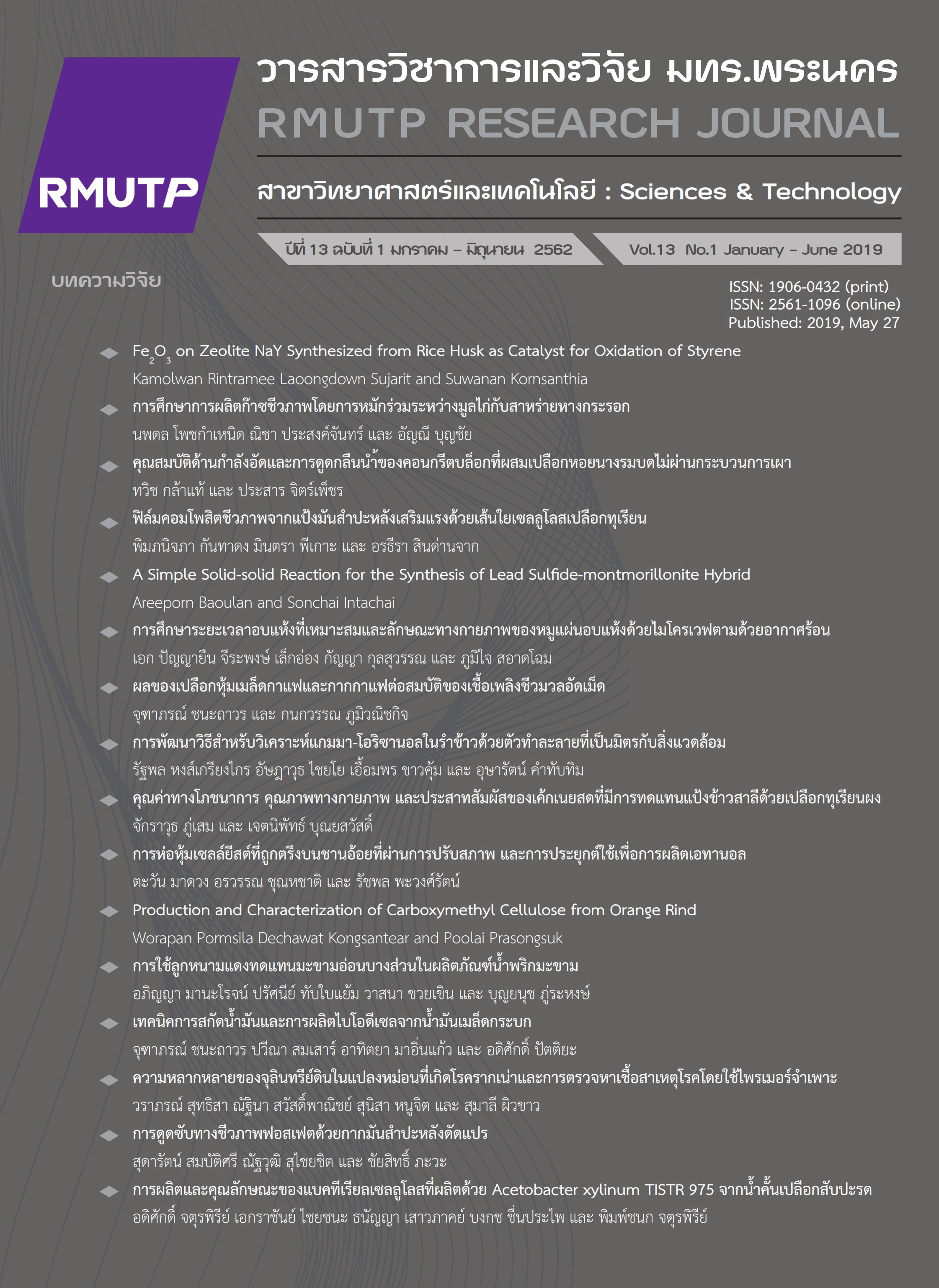Bio-composite Films based on Cassava Starch Reinforced with Durian Rind Cellulose Fibers
Main Article Content
Abstract
This research aimed to develop compound of prototypes polymer bio-composites from cassava starch (CS) reinforced with agriculture residue, the rind of durian fruit. Cellulose extracted from durian rind using hot sodium hydroxide and bleaching treatment with hydrogen peroxide. The removal of lignin and hemicellulose components from durian rind were investigated by fourier transform infrared spectroscopy (FT-IR). Cassava starch bio-composite films were prepared by solution-casting technique which includes 0-50 wt% of durian rind (DR) or durian rind cellulose (DRC) as reinforcement agent and urea/glycerol (GU ratio = 50:50) as plasticizer. The physical and chemical properties of thermoplastic starch (TPS)/DR and TPS/DRC bio-composite films were investigated. The percent elongation at break of bio-composite films were increased when compared to control CS film. From 15TPS/DR (80/20) films showed increase the elongation at break from 7.28 to 14.00% when compared to CS control films. While 15TPS/DRC (80/20) bio-composite films exhibited that the highest elongation at break to 77%. Durian fiber (DR or DRC) loading decreased the water absorption of plasticized bio-composite films. Furthermore, incorporation of DRC in composite can be enhanced film stability in water better than DR. Therefore, the effect of DRC reinforcement agent on TPS bio-composite films can improve water resistance and mechanical properties, especially in terms of flexibility. Finally, the waste of bio-composite films was degraded completely in soil burial test.
Article Details
References
[2] Y.X. Xu, K.M. Kim, M.A. Hanna and D. Nag, “Chitosan-starch composite film: preparation and characterization,” Industrial Crops and Products, vol. 21, pp. 185-192, 2005.
[3] P. Khongjangreed, S. Sirisom, C. Chotichayapong, A. Paphongam, P. Sawadee, W. Punyodom and P. Kunthadong, “Preparation and properties testing of environmentally biodegradable based on starch for agricultural application,” in Proceeding MACRO 2014, Chiang Mai, Thailand, 2014, pp. 92-94.
[4] V. Grazuleviciene, J. Treinyte and E. Zaleckas, “Film-forming starch composites for agricultural applications,” Journal of Polymers and the Environmental, vol. 20, pp. 485-491, June. 2012.
[5] X.F. Ma, J.G. Yu and J.J. Wan, “Urea and ethanolamine as a mixed plasticizer for thermoplastic starch,” Carbohydrate Polymers, vol. 64, pp. 267-273, Jan. 2006.
[6] K.H. Song and I.S. Kim, “Effects of plasticizer on the mechanical properties of kenaf/starch bio-composites,” Fibers and Polymers, vol. 14, pp. 2135-2140, Aug. 2013.
[7] O. Shinji, “Durability of Starch Based Biodegradable plastics reinforced with Manila hemp fibers,” Materials, vol. 4, pp. 457-468, Feb. 2011.
[8] M.Z. Selamat, M. Razi, A.N. Kasim, D.M. Sivakumar, P. Azma, M.A.M. Daud and Y. Yuhazri, “Mechanical properties of starch composite reinforced by pineapple leaf fiber (PLF) from josapine cultivar,” ARPN Journal of Engineering and Applied Sciences, vol. 11, pp. 9783-9788, 2016.
[9] H. Ibrahim, M. Farag, H. Megahed and S. Mehanny, “Characteristics of starch-based biodegradable composites reinforced with date palm and flax fibers,” Carbohydrate Polymers, vol. 101, pp. 11-19, Jan. 2014.
[10] A.K. Bledzki and J. Gassan, “Composites reinforced with cellulose based fibrres,” Progress in Polymer Science, vol. 24, pp. 221-274, 1990.
[11] J.D. McMillan, “Pretreatment of lignocellulosic biomass,” in Enzymatic conversion of biomass for fuels production, vol. 566, M.E. Himmel, J.O. Baker and R.P. Overend, American Chemistry Society, 1994, pp. 292-324.
[12] L. Luenam and J. Temprateep, “Study of materials to abandon remain from process to arrange flesh durian for fryer,” RMUTTO Journal, vol. 1, pp. 36-40, Jan. 2009.
[13] P. Rachtanapun, S. Luangkamin, K. Tanprasert and R. Suriyatem, “Carboxymethyl cellulose film from durian rind,” LWT – Food Science and Technology, vol. 48, pp. 52-58, 2012.
[14] J. Cai and L. Zhang, “Rapid dissolution of cellulose in LiOH/Urea and NaOH/Urea aqueous solution,” Macromolecular Bioscience, vol. 5, pp. 539-548, 2005.
[15] J. Rueangyodjantana and R. Buntem, “Cellulose extraction and paper making from Khoi bark,” Veridian E-Journal, Science and Technology Silpakorn University, vol. 4, pp. 50-59, May. 2017.
[16] 46th JECFA, “Microcrystalline Cellulose,” in Compendium of Food Additive Specification: Addendum 5, Joint FAO/WHO Expert Committee on Food Additives 49th session, Rome, 1997, pp.71-73.
[17] M.R. Manshor, H. Anuar, M.N. Nur Aimi, M.I. Ahmad Fitrie, W.B. Wan Nazri, S.M. Sapuan, Y.A. El-Shekeil and M.U. Wahit, “Mechanical, thermal and morphological properties of durian skin fibre reinforced PLA biocomposites,” Materials and Design, vol. 59, pp. 279-286, Mar. 2014.
[18] H. Yang, R. Yan, H. Chen, D.H. Lee and C. Zheng, “Characteristics of hemicellulose, cellulose and lignin pyrolysis,” Fuel, vol. 86, pp. 1781-1788, 2007.
[19] S. Sanchez-Valdes, L.F.D. Valle and O. Manero, “Polymer Blends,” in Handbook of polymer synthesis, characterization, and processing, vol. 628, E. Saldivar-Guerra and E. Vivaldo-Lima, John Wiley & Sons, Inc., 2013, pp. 505-517.


